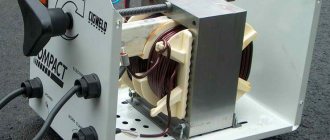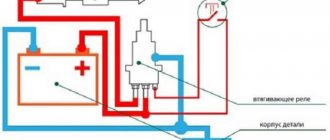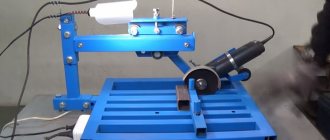One of the simplest ways to measure current in an electrical circuit is to measure the voltage drop across a resistor in series with the load. But when current passes through this resistor, useless power is released in the form of heat, so it is selected to the minimum possible value, which in turn entails a subsequent amplification of the signal. It should be noted that the circuits given below make it possible to control not only direct, but also pulsed current, however, with corresponding distortions determined by the bandwidth of the amplifying elements.
The circuit for measuring the load current in the negative pole is shown in Figure 1. This circuit and part of the information are borrowed from the magazine “Components and Technologies” No. 10, 2006. Mikhail Pushkarev [email protected] Advantages: • low input common-mode voltage; • input and output signals have a common ground; • ease of implementation with one power supply. Disadvantages: • the load does not have a direct connection with the “ground”; • there is no possibility of switching the load with a switch in the negative pole; • the possibility of failure of the measuring circuit due to a short circuit in the load.
Measuring the current in the negative pole of the load is not difficult. Many op-amps designed to operate with a single-supply supply are suitable for this purpose. The circuit for measuring current using an operational amplifier is shown in Fig. 1. The choice of a specific type of amplifier is determined by the required accuracy, which is mainly affected by the amplifier's zero offset, its temperature drift and gain setting error, and the required circuit speed. At the beginning of the scale, a significant conversion error is inevitable, caused by a non-zero value of the amplifier's minimum output voltage, which is not significant for most practical applications. To eliminate this drawback, a bipolar amplifier power supply is required.
Measuring current in the positive pole of the load
Advantages: • the load is grounded;
• a short circuit in the load is detected. Disadvantages: • high common-mode input voltage (often very high); • the need to shift the output signal to a level acceptable for subsequent processing in the system (reference to ground). Let's consider circuits for measuring current in the positive pole of the load using operational amplifiers. In the diagram in Fig. 2, you can use any of the operational amplifiers suitable for the permissible supply voltage, designed to operate with a single-supply supply and a maximum input common-mode voltage reaching the supply voltage, for example AD8603. The maximum supply voltage of the circuit cannot exceed the maximum permissible supply voltage of the amplifier.
But there are op-amps that are capable of operating at an input common-mode voltage significantly higher than the supply voltage. In the circuit using the LT1637 op-amp shown in Fig. 3, the load supply voltage can reach 44 V with an op-amp supply voltage of 3 V. Instrumentation amplifiers such as LTC2053, LTC6800 from Linear Technology, INA337 from Texas Instruments are suitable for measuring current in the positive pole of the load with a very small error. There are also specialized microcircuits for measuring current in the positive pole, for example, INA138 and INA168.
Advantages and applications of LM358
The operational amplifier has a number of advantages that need to be mentioned. So, this device has high sensitivity, excellent compactness and excellent reliability. In addition, it is universal in use, because it does not include complex nodes in its system that act as interference.
As we said earlier, our device operates in both bipolar and unipolar processes, this is explained by the high speed and maximum possible frequency of signal emission.
Due to the presence of such high-quality and effective properties, LM358 finds wide application in people's lives. It is used in:
- Set-top boxes, turntables and DVD players;
- Homemade film panoramas;
- Gas meters and meters;
- Simple players;
- Digital nodes and installations;
- Multimedia systems;
- Field transmitters;
- Electric motor installations;
- Engines and generators;
- Thermometer sensors;
- Libra.
INA138 and INA168
— high-voltage, unipolar current monitors. A wide range of input voltages, low current consumption and small dimensions - SOT23, allow this chip to be used in many circuits. Power supply voltage is from 2.7 V to 36 V for INA138 and from 2.7 V to 60 V for INA168. The input current is no more than 25 µA, which allows you to measure the voltage drop across the shunt with minimal error. Microcircuits are current-voltage converters with a conversion coefficient from 1 to 100 or more. INA138 and INA168 in SOT23-5 packages have an operating temperature range of -40°C to +125°C. A typical connection diagram is taken from the documentation for these microcircuits and is shown in Figure 4.
Description of the LM358 chip
Confirmation of the high popularity of the microcircuit is its performance characteristics, which allow the creation of many different devices. The main indicative characteristics of the component include the following.
Acceptable operating parameters: the microcircuit provides single and bipolar power supply, a wide range of supply voltages from 3 to 32 V, an acceptable slew rate of the output signal equal to only 0.6 V/μs. Also, the chip consumes only 0.7 mA, and the offset voltage is only 0.2 mV.
OPA454
- a new low-cost high-voltage operational amplifier from Texas Instruments with an output current of more than 50 mA and a bandwidth of 2.5 MHz. One of the advantages is the high stability of the OPA454 at unity gain.
Protection against overtemperature and overcurrent is organized inside the op-amp. The IC operates over a wide range of supply voltages from ±5 to ±50 V or, in the case of a single-supply supply, from 10 to 100 V (maximum 120 V). The OPA454 has an additional “Status Flag” pin - an open-drain op-amp status output - which allows you to work with logic at any level. This high-voltage operational amplifier features high precision, wide output voltage range, and no phase inversion problems often encountered with simple amplifiers. Technical features of OPA454: Wide range of supply voltages from ±5 V (10 V) to ±50 V (100 V) (maximum up to 120 V) Large maximum output current > ±50 mA Wide operating temperature range from -40 to 85 ° C ( maximum from -55 to 125°C) Package version SOIC or HSOP (PowerPADTM) Data on the microcircuit are given in “Electronics News” No. 7 for 2008. Sergey Pichugin
DataSheet
LM158, LM158A, LM258, LM258A LM358, LM358A, LM2904, LM2904V - Dual operational amplifiers.
Buy LM358 on aliexpress or buy with cashback!
1 Features
- Wide supply voltage range
- Single supply: 3 V to 32 V (26 V for LM2904)
— Bipolar power: from ±1.5 V to ±16 V (±13 V for LM2904)
- Minimum current consumption, independent of supply voltage:
- Uniform gain across entire bandwidth: 0.7 MHz
- Low input bias current and bias parameters
— Zero offset compensation input voltage: 3 mV
For version with letter A: 2 mV
— Input zero offset compensation current: 2 nA
— Input bias current: 20 nA
For version with letter A: 15 nA
- Differential input voltage range equals maximum rated supply voltage: 32V (26V for LM2904)
- Open-circuit differential voltage gain: 100 dB
- Internal frequency compensation
- All products comply with MIL-PRF-38535 standard
2 Application
- Blu-ray players and home theaters
- Chemical and gas sensors
- DVD recorders and players
- Digital Multimeters: Bench and Systems
- Digital Multimeters: Handhelds
- Field transmitters: temperature sensors
- Motor control: asynchronous, brushed DC, brushless DC, high and low voltage circuits, permanent magnets and stepper motors
- Oscilloscopes
- TV: LCD displays and digital boards
- Temperature sensors and controllers using Modbus
- Scales
3 Description
These ICs consist of two independent, high-gain, frequency-compensated operational amplifiers designed to operate from a single or dual power supply over a wide voltage range.
Device Information
| Serial number | Frame | Dimensions (Nom.) |
| LMx58, LMx58x, LM2904, LM2904V | VSSOP (8) | 3.00 mm × 3.00 mm |
| SOIC (8) | 4.90 mm × 3.90 mm | |
| SO(8) | 5.20 mm × 5.30 mm | |
| TSSOP (8) | 3.00 mm × 4.40 mm | |
| PDIP (8) | 9.81 mm × 6.35 mm | |
| LMx58, LMx58x, LM2904V | CDIP (8) | 9.60 mm × 6.67 mm |
| LCCC (20) | 8.89 mm × 8.89 mm |
Designation (for each amplifier)
Pin locations and functions
Rice. 1 Pinout for D, DGK, P, PS, PW, JG, 8-Pin SOIC, VSSOP, PDIP, SO, TSSOP, CDIP (Top View)
Rice.
2 FK 20-Pin LCCC Housing (Top View) NC - Internally Unused Pins
Pin Assignment
| Conclusion | I/O | Description | ||
| Designation | LCCC NO. | SOIC, SSOP, CDIP, PDIP SO, TSSOP, CFP NO. | ||
| 1IN– | 5 | 2 | I | Inverting input |
| 1IN+ | 7 | 3 | I | Non-inverting input |
| 1OUT | 2 | 1 | O | Exit |
| 2IN– | 15 | 6 | I | Inverting input |
| 2IN+ | 12 | 5 | I | Non-inverting input |
| 2OUT | 17 | 7 | O | Exit |
| GND | 10 | 4 | — | Earth |
| NC | 1 | — | — | Not connected |
| 3 | ||||
| 4 | ||||
| 6 | ||||
| 8 | ||||
| 9 | ||||
| 11 | ||||
| 13 | ||||
| 14 | ||||
| 16 | ||||
| 18 | ||||
| 19 | ||||
| VCC | — | 8 | — | Supply voltage |
| VCC+ | 20 | — | — | Supply voltage |
5 Specification
5.1 Absolute maximum values
Operating temperature range (unless otherwise stated)(1)
| LMx58, LMx58x, LM2904V | LM2904 | Unit Change | ||||||
| MIN | MAX | MIN | MAX | |||||
| VCC | Supply voltage(2) | –0.3 | ±16 or 32 | –0.3 | ±13 or 26 | IN | ||
| VID | Differential Input Voltage(3) | –32 | 32 | –26 | 26 | IN | ||
| VI | Any entrance | Input voltage | –0.3 | 32 | –0.3 | 26 | IN | |
| Output to ground short circuit duration (for one amplifier) TA = 25°C, VCC ≤ 15 V(4) | Unlimited | Unlimited | With | |||||
| T.A. | Outdoor operating temperature | LM158, LM158A | –55 | 125 | °C | |||
| LM258, LM258A | –25 | 85 | ||||||
| LM358, LM358A | 0 | 70 | ||||||
| LM2904 | –40 | 125 | –40 | 125 | ||||
| T.J. | Effective pn junction temperature | 150 | 150 | °C | ||||
| Case temperature for 60 seconds | FK housing | 260 | °C | |||||
| Solder temperature across the body for 60 seconds | JG body | 300 | 300 | °C | ||||
| Tstg | Storage temperature | –65 | 150 | –65 | 150 | °C | ||
(1) Absolute maximum values indicate limits which, if exceeded, may result in damage to the device. Electrical specifications do not apply when the device is operated outside its stated operating conditions. Exposing a device to absolute maximum values over a long period of time may affect its reliability.
(2) All voltages (except differential and supply voltages) are measured relative to ground.
(3) Differential voltage at IN+, relative to IN−.
(4) Shorting the VCC pins can cause overheating and possible failure.
5.2 Electrostatic characteristics
| Meaning | Unit change | |||
| V(ESD) | Electrostatic discharge | Human Body Model (HBM), per ANSI/ESDA/JEDEC JS-001(1) | ±500 | IN |
| Device Model (CDM), according to JEDEC specification JESD22-C101 | ±1000 | |||
5.3 Recommended conditions
In operating temperature range (unless otherwise stated)
| LMx58, LMx58x, LM2904V | LM2904 | Unit change | |||||
| MIN | MAX | MIN | MAX | ||||
| VCC | Supply voltage | 3 | 30 | 3 | 26 | IN | |
| VCM | Common Mode Voltage | 0 | VCC – 2 | 0 | VCC – 2 | IN | |
| T.A. | Outdoor operating temperature | LM158 | –55 | 125 | °C | ||
| LM2904 | –40 | 125 | –40 | 125 | |||
| LM358 | 0 | 70 | |||||
| LM258 | –25 | 85 | |||||
5.4 Thermal characteristics
| Thermal characteristics | LMx58, LMx58x, LM2904V, LM2904 | LMx58, LMx58x, LM2904V | LMx58, LMx58x, LM2904V | Unit Change | ||||||||||
| D(SOIC) | DGK (VSSOP) | P(PDIP) | PS (SO) | PW (TSSOP) | FK (LCCC) | JG (CDIP) | ||||||||
| 8 PINS | 8 PINS | 8 PINS | 8 PINS | 8 PINS | 20 PINS | 8 PINS | ||||||||
| RθJA | Thermal resistance crystal-environment | 97 | 172 | 85 | 95 | 149 | — | — | °C/W | |||||
| RθJC(top) | Thermal resistance crystal - case | 72.2 | — | — | — | — | 5.61 | 14.5 | ||||||
6.5 Electrical characteristics for LMx58
Over the specified temperature range, VCC = 5 V (unless otherwise noted)
| Parameter | Terms(1) | TA(2) | LM158 LM258 | LM358 | Unit change | ||||||
| MIN | TYP(3) | MAX | MIN | TYP(3) | MAX | ||||||
| VIO | Zero offset compensation input voltage | VCC = 5 V to MAX, VIC = VICR(min), VO = 1.4 V | 25°C | 3 | 5 | 3 | 7 | mV | |||
| Whole range | 7 | 9 | |||||||||
| αVIO | Average temperature coefficient of input zero offset voltage | Whole range | 7 | 7 | µV/°C | ||||||
| IIO | Input zero offset compensation current | VO = 1.4 V | 25°C | 2 | 30 | 2 | 50 | nA | |||
| Whole range | 100 | 150 | |||||||||
| αIIO | Average temperature coefficient of input zero offset current | Whole range | 10 | 10 | pA/°C | ||||||
| IIB | Input bias current | VO = 1.4 V | 25°C | –20 | –150 | –20 | –250 | nA | |||
| Whole range | –300 | –500 | |||||||||
| VICR | Input common mode voltage range | VCC = 5V to MAX | 25°C | from 0 to VCC – 1.5 | from 0 to VCC – 1.5 | IN | |||||
| Whole range | 0 to VCC – 2 | 0 to VCC – 2 | |||||||||
| VOH | High output voltage level | RL ≥ 2 kOhm | 25°C | VCC – 1.5 | VCC – 1.5 | IN | |||||
| RL ≥ 10 kOhm | 25°C | ||||||||||
| VCC = MAX | RL = 2 kOhm | Whole range | 26 | 26 | |||||||
| RL ≥ 10 kOhm | Whole range | 27 | 28 | 27 | 28 | ||||||
| VOL | Low output voltage | RL ≤ 10 kOhm | Whole range | 5 | 20 | 5 | 20 | mV | |||
| AVD | Large differential voltage gain signal | VCC = 15 V VO = 1 V to 11 V, RL ≥ 2 kOhm | 25°C | 50 | 100 | 25 | 100 | V/mV | |||
| Whole range | 25 | 15 | |||||||||
| CMRR | Common mode rejection ratio | VCC= 5V to MAX, VIC = VICR(min) | 25°C | 70 | 80 | 65 | 80 | dB | |||
| kSVR | Power supply noise rejection ratio (ΔVDD /ΔVIO) | VCC = 5V to MAX | 25°C | 65 | 100 | 65 | 100 | dB | |||
| VO1/VO2 | Crosstalk | f = 1 kHz to 20 kHz | 25°C | 120 | 120 | dB | |||||
| IO | Output current | VCC = 15 V, VID = 1 V, VO = 0 | Source | 25°C | –20 | –30 | –20 | –30 | mA | ||
| Whole range | –10 | –10 | |||||||||
| VCC = 15 V, VID = –1 V, VO = 15 V | Receiver | 25°C | 10 | 20 | 10 | 20 | |||||
| Whole range | 5 | 5 | |||||||||
| VID = from –1 V, VO = 200 mV | 25°C | 12 | 30 | 12 | 30 | µA | |||||
| iOS | Output short circuit current | VCC about 5 V, GND about –5 V, VO = 0 | 25°C | ±40 | ±60 | ±40 | ±60 | mA | |||
| ICC | Current consumption (two amplifiers) | VO = 2.5 V, No load | Whole range | 0.7 | 1.2 | 0.7 | 1.2 | mA | |||
| VCC = MAX, VO = 0.5 VCC, No load | Whole range | 1 | 2 | 1 | 2 | ||||||
(1) All specifications measured in open circuit with zero input common mode voltage unless otherwise noted. MAX VCC for testing is 26V for LM2902 and 30V for others.
(2) The entire range is -55°C to 125°C for LM158, -25°C to 85°C for LM258, and 0°C to 70°C for LM358, and -40°C to 125°C for LM2904.
(3) All typical values for temperature TA = 25°C
6.6 Electrical characteristics for LM2904
Over the specified temperature range, VCC = 5 V (unless otherwise noted)
| Parameter | Terms(1) | TA(2) | LM2904 | Unit change | ||||
| MIN | TYP(3) | MAX | ||||||
| VIO | Zero offset compensation input voltage | VCC = 5 V to MAX, VIC = VICR(min), VO = 1.4 V | Without A suffix in markings | 25°C | 3 | 7 | mV | |
| Whole range | 10 | |||||||
| With A suffix in marking | 25°C | 1 | 2 | |||||
| Whole range | 4 | |||||||
| αVIO | Average temperature coefficient of input zero offset voltage | Whole range | 7 | µV/°C | ||||
| IIO | Input zero offset compensation current | VO = 1.4 V | Without V suffix in markings | 25°C | 2 | 50 | on | |
| Whole range | 300 | |||||||
| With V suffix in markings | 25°C | 2 | 50 | |||||
| Whole range | 150 | |||||||
| αIIO | Average temperature coefficient of input zero offset current | Whole range | 10 | pA/°C | ||||
| IIB | Input bias current | VO = 1.4 V | 25°C | –20 | –250 | nA | ||
| Whole range | –500 | |||||||
| VICR | Input common mode voltage range | VCC = 5V to MAX | 25°C | from 0 to VCC – 1.5 | IN | |||
| Whole range | 0 to VCC – 2 | |||||||
| VOH | High output voltage level | RL ≥ 10 kOhm | 25°C | VCC – 1.5 | IN | |||
| VCC = MAX, Without V suffix | RL = 2 kOhm | Whole range | 22 | |||||
| RL ≥ 10 kOhm | Whole range | 23 | 24 | |||||
| VCC = MAX With V suffix | RL = 2 kOhm | Whole range | 26 | |||||
| RL ≥ 10 kOhm | Whole range | 27 | 28 | |||||
| VOL | Low output voltage | RL ≤ 10 kOhm | Whole range | 5 | 20 | mV | ||
| AVD | Large differential voltage gain signal | VCC = 15 V, VO = 1 V to 11 V, RL ≥ 2 kOhm | 25°C | 25 | 100 | V/mV | ||
| Whole range | 15 | |||||||
| CMRR | Common mode rejection ratio | VCC = 5V to MAX, VIC = VICR(min) | Without V suffix | 25°C | 50 | 80 | dB | |
| With V suffix | 25°C | 65 | 80 | |||||
| kSVR | Power supply noise rejection ratio (ΔVCC /ΔVIO) | VCC = 5V to MAX | 25°C | 65 | 100 | dB | ||
| VO1/VO2 | Crosstalk | f = 1 kHz to 20 kHz | 25°C | 120 | dB | |||
| IO | Output current | VCC = 15 V, VID = 1 V, VO = 0 | Source | 25°C | –20 | –30 | mA | |
| Whole range | –10 | |||||||
| VCC = 15 V, VID = –1 V, VO = 15 V | Receiver | 25°C | 10 | 20 | ||||
| Whole range | 5 | |||||||
| VID = –1 V, VO = 200 mV | Without V suffix | 25°C | 30 | µA | ||||
| With V suffix | 25°C | 12 | 40 | |||||
| iOS | Output short circuit current | VCC about 5 V, VO = 0, GND about −5 V | 25°C | ±40 | ±60 | mA | ||
| ICC | Current consumption (four amplifiers) | VO = 2.5 V, No load | Whole range | 0.7 | 1.2 | mA | ||
| VCC = MAX, VO = 0.5 VCC, No load | Whole range | 1 | 2 | |||||
(1) All specifications measured in open circuit with zero input common mode voltage unless otherwise noted. MAX VCC for testing is 26V for LM2902 and 30V for others.
(2) The entire range is -55°C to 125°C for LM158, -25°C to 85°C for LM258, and 0°C to 70°C for LM358, and -40°C to 125°C for LM2904.
(3) All typical values for temperature TA = 25°C
5.7 Electrical characteristics for LM158A and LM258A
Over the specified temperature range, VCC = 5 V (unless otherwise noted)
| Parameter | Terms(1) | TA(1) | LM158A | LM258A | Unit change | ||||||
| MIN | TYP(2) | MAX | MIN | TYP(2) | MAX | ||||||
| VIO | Zero offset compensation input voltage | VCC = 5 V to 30 V, VIC = VICR(min), VO = 1.4 V | 25°C | 2 | 2 | 3 | mV | ||||
| Whole range | 4 | 4 | |||||||||
| αVIO | Average temperature coefficient of input zero offset voltage | Whole range | 7 | 15 | 7 | 15 | µA/°C | ||||
| IIO | Input zero offset compensation current | VO = 1.4 V | 25°C | 2 | 10 | 2 | 15 | nA | |||
| Whole range | 30 | 30 | |||||||||
| αIIO | Average temperature coefficient of input zero offset current | Whole range | 10 | 200 | 10 | 200 | pA/°C | ||||
| IIB | Input bias current | VO = 1.4 V | 25°C | –15 | –50 | –15 | –80 | nA | |||
| Whole range | –100 | –100 | |||||||||
| VICR | Input common mode voltage range | VCC = 30 V | 25°C | from 0 to VCC – 1.5 | from 0 to VCC – 1.5 | IN | |||||
| Whole range | 0 to VCC – 2 | 0 to VCC – 2 | |||||||||
| VOH | High output voltage level | RL ≥ 2 kOhm | 25°C | VCC – 1.5 | VCC – 1.5 | IN | |||||
| VCC = 30 V | RL= 2 kOhm | Whole range | 26 | 26 | |||||||
| RL≥ 10 kOhm | Whole range | 27 | 28 | 27 | 28 | ||||||
| VOL | Low output voltage | RL ≤ 10 kOhm | Whole range | 5 | 20 | 5 | 20 | mV | |||
| AVD | Large differential voltage gain signal | VCC = 15 V, VO = 1 V to 11 V, RL ≥ 2 kOhm | 25°C | 50 | 100 | 50 | 100 | V/mV | |||
| Whole range | 25 | 25 | |||||||||
| CMRR | Common mode rejection ratio | 25°C | 70 | 80 | 70 | 80 | dB | ||||
| kSVR | Power supply noise suppression ratio (ΔVD /ΔVIO) | 25°C | 65 | 100 | 65 | 100 | dB | ||||
| VO1/VO2 | Crosstalk | f = 1 kHz to 20 kHz | 25°C | 120 | 120 | dB | |||||
| IO | Output current | VCC = 15 V, VID = 1 V, VO = 0 | Source | 25°C | –20 | –30 | –60 | –20 | –30 | −60 | mA |
| Whole range | –10 | –10 | |||||||||
| VCC = 15 V, VID = –1 V, VO = 15 V | Receiver | 25°C | 10 | 20 | 10 | 20 | |||||
| Whole range | 5 | 5 | |||||||||
| VID = −1 V, VO = 200 mV | 25°C | 12 | 30 | 12 | 30 | µA | |||||
| iOS | Output short circuit current | VCC about 5 V, GND about –5 V, VO = 0 | 25°C | ±40 | ±60 | ±40 | ±60 | mA | |||
| ICC | Current consumption (four amplifiers) | VO = 2.5 V, No load | Whole range | 0.7 | 1.2 | 0.7 | 1.2 | mA | |||
| VCC = MAX V, VO = 0.5 V, No load | Whole range | 1 | 2 | 1 | 2 | ||||||
(1) All specifications measured in open circuit with zero input common mode voltage unless otherwise noted. MAX VCC for testing is 26V for LM2902 and 30V for others.
(2) All typical values for temperature TA = 25°C
5.8 Electrical characteristics for LM358A
Over the specified temperature range, VCC = 5 V (unless otherwise noted)
| Parameter | Terms(1) | TA(1) | LM358A | Unit Change | ||||
| MIN | TYP(2) | MAX | ||||||
| VIO | Zero offset compensation input voltage | VCC = 5 to 30 V, VIC = VICR(min), VO = 1.4 V | 25°C | 2 | 3 | mV | ||
| Whole range | 5 | |||||||
| αVIO | Average temperature coefficient of input zero offset voltage | Whole range | 7 | 20 | µA/°C | |||
| IIO | Input zero offset compensation current | VO = 1.4 V | 25°C | 2 | 30 | nA | ||
| Whole range | 75 | |||||||
| αIIO | Average temperature coefficient of input zero offset current | Whole range | 10 | 300 | pA/°C | |||
| IIB | Input bias current | VO = 1.4 V | 25°C | –15 | –100 | nA | ||
| Whole range | –200 | |||||||
| VICR | Input common mode voltage range | VCC = 30 V | 25°C | from 0 to VCC – 1.5 | IN | |||
| Whole range | 0 to VCC – 2 | |||||||
| VOH | High output voltage level | RL ≥ 2 kOhm | 25°C | VCC – 1.5 | IN | |||
| VCC = 30 V | RL= 2 kOhm | Whole range | 26 | |||||
| RL≥ 10 kOhm | Whole range | 27 | 28 | |||||
| VOL | Low output voltage | RL ≤ 10 kOhm | Whole range | 5 | 20 | mV | ||
| AVD | Large differential voltage gain signal | VCC = 15 V, VO = 1 V to 11 V, RL ≥ 2 kOhm | 25°C | 25 | 100 | V/mV | ||
| Whole range | 15 | |||||||
| CMRR | Common mode rejection ratio | 25°C | 65 | 80 | dB | |||
| kSVR | Power supply noise rejection ratio (ΔVDD /ΔVIO) | 25°C | 65 | 100 | dB | |||
| VO1/VO2 | Crosstalk | f = 1 kHz to 20 kHz | 25°C | 120 | dB | |||
| IO | Output current | VCC = 15 V, VID = 1 V, VO = 0 | Source | 25°C | –20 | –30 | −60 | mA |
| Whole range | –10 | |||||||
| VCC = 15 V, VID = –1 V, VO = 15 V | Receiver | 25°C | 10 | 20 | ||||
| Whole range | 5 | |||||||
| VID = –1 V, VO = 200 mV | 25°C | 30 | µA | |||||
| iOS | Output short circuit current | VCC about 5 V, GND about –5 V, VO = 0 | 25°C | ±40 | ±60 | mA | ||
| ICC | Current consumption (four amplifiers) | VO = 2.5 V, No load | Whole range | 0.7 | 1.2 | mA | ||
| VCC = MAX V, VO = 0.5 V, No load | Whole range | 1 | 2 | |||||
(1) All specifications measured in open circuit with zero input common mode voltage unless otherwise noted. MAX VCC for testing is 26V for LM2902 and 30V for others.
(2) All typical values for temperature TA = 25°C
6 Operating conditions
VCC = ±15 V, TA = 25°C
| Parameter | Conditions | TYP | Unit change | |
| S.R. | Slew rate at unity gain | RL = 1 MΩ, CL = 30 pF, VI = ±10 V (see Fig. 3) | 0.3 | V/μs |
| B1 | Bandwidth at unity gain | RL = 1 MΩ, CL = 20 pF (see Fig. 3) | 0.7 | MHz |
| Vn | Equivalent noise voltage referred to input | RS = 100 Ohm, VI = 0 V, f = 1 kHz (see Fig. 4) | 40 | nV/√Hz |
Rice. 3 Unity gain amplifier
Rice. 4 Circuit for checking noise
7 Application
A typical application of an op amp is as an inverting amplifier. This amplifier takes a positive voltage at the input and converts it to a negative voltage of the same magnitude. In the same way, it converts negative voltage into positive voltage.
Rice. 5 Application - connection diagram
The supply voltage must be greater than the signal input and output voltage ranges. For example, if a signal will be amplified from ±0.5 V to ±1.8 V, a supply voltage of ±12 V will be sufficient.
The required gain for the inverting amplifier is calculated using formulas (1) and (2):
Av=Vout/Vin (1)
For example Av=1.8/-0.5=-3.6 (2)
Once the gain is determined, RI or RF values are selected. It is advisable to select the resistance value in kOhms, since the circuit will use currents in mA. This ensures that too much current is not consumed. For this example, we will choose RI=10 kOhm, which gives RF=36 kOhm. RF is calculated using formula (3): Av=-RF/RI.
Rice. 6 Input and output voltages on the inverting amplifier
If you find an error, please select a piece of text and press Ctrl+Enter.
Current shunt signal amplifier on the main power bus.
In amateur radio practice, for circuits whose parameters are not so stringent, cheap dual LM358 op-amps are suitable, allowing operation with input voltages up to 32V. Figure 5 shows one of many typical circuits for connecting the LM358 chip as a load current monitor. By the way, not all “datasheets” have diagrams for turning it on. In all likelihood, this circuit was the prototype of the circuit presented in the Radio magazine by I. Nechaev and which I mentioned in the article “ Current Limit Indicator ”. The above circuits are very convenient to use in homemade power supplies for monitoring, telemetry and load current measurement, and for constructing short circuit protection circuits. The current sensor in these circuits can have a very small resistance and there is no need to adjust this resistor, as is done in the case of a conventional ammeter. For example, the voltage across resistor R3 in the circuit in Figure 5 is equal to: Vo = R3∙R1∙IL / R2 i.e. Vo = 1000∙0.1∙1A / 100 = 1V. One ampere of current flowing through the sensor corresponds to one volt of voltage drop across resistor R3. The value of this ratio depends on the value of all resistors included in the converter circuit. It follows that by making resistor R2 a trimmer, you can easily use it to compensate for the spread in the resistance of resistor R1. This also applies to the circuits shown in Figures 2 and 3. In the circuit shown in Fig. 4, the resistance of the load resistor RL can be changed. To reduce the dip in the output voltage of the power supply, it is generally better to take the resistance of the current sensor - resistor R1 in the circuit in Fig. 5 equal to 0.01 Ohm, while changing the value of resistor R2 to 10 Ohm or increasing the value of resistor R3 to 10 kOhm.
Types of LM358
There are several types of op amps that we are talking about. Firstly, it should be noted that there is not one classification feature, but three at once.
The “systematization” should begin with such a feature as the area of use.
So, there are programmable and alternative types. If we talk about the first, then it must be said that they are very cheap and easily accessible, because, as a rule, they are in “circulation” only in measuring modes. But the latter, in turn, are distinguished by a high price, since their structures contain powerful units that can minimize the consumption of external load, which ensures absolute safety from short circuits of the entire electrical system.
Now let's move on to the division by “bases”: there are electronic (1) and polar (2). 1 - work due to their intensive control of the flow of particles that move between the cathode and anode, that is, minus and plus. 2 - operate by regulating and monitoring the resistance value at the terminals, which determines the direction of the initial signal.
And, of course, the third sorting. It is determined by the speed of operation of the electrical appliance. Of course, we will consider high-speed and medium-acting ones.
“CUs” are characterized by the maximum possible displacement speed, because they contain several differential outputs. But “SU” is completely the opposite - they do not possess the required amount of the above-mentioned elements, and also have a low emission frequency during a unipolar process.
LM358 pinout
Since the LM358 contains two operational amplifiers, each with two inputs and one output (6 pins) and two contacts needed for power supply, a total of 8 contacts are obtained.
LM358 are packaged in both volume-mount packages (LM358N - DIP8) and surface-mount packages (LM358D - SO8). There is also a metal-ceramic version for particularly difficult working conditions. I used the LM358 only for surface mounting - it’s easy and convenient to solder.
In what packages are microcircuits produced?
On the package there may be DIP8 - designation LM358N or SO8 - LM358D. The first is intended for volumetric mounting, the second is for surface mounting. The characteristics of the element do not depend on the type of housing: they are always the same. But there are many analogues of the microcircuit, whose parameters are slightly different. There are always pros and cons. Typically, if an element has a wide operating voltage range, for example, some other characteristic will suffer.
There is also a metal-ceramic case, but such microcircuits are used if the device will be used in difficult conditions. In amateur radio practice, it is more convenient to use microcircuits in surface-mount housings. They weld very well, which is important when working. After all, working with elements on long legs turns out to be much more comfortable.
Analogs LM358
Complete analogs of LM358 from different manufacturers NE532, OP04, OP221, OP290, OP295, OPA2237, TA75358P, UPC358C. For LM358D - KIA358F, NE532D, TA75358CF, UPC358G.
Along with the LM358, a large number of similar operational amplifiers are produced. For example, LM158, LM258, LM2409 have similar characteristics, but different operating temperature ranges.
| Type | Minimum temperature, °C | Maximum temperature, °C | Supply voltage range, V |
| LM158 | -55 | 125 | from 3(±1.5) to 32(±16) |
| LM258 | -25 | 85 | from 3(±1.5) to 32(±16) |
| LM358 | 70 | from 3(±1.5) to 32(±16) | |
| LM358 | -40 | 85 | from 3(±1.5) to 26(±13) |
If the range of 0..70 degrees is not enough, then you should use LM2409, however, you should take into account that its power range is narrower:
By the way, if you need only one operational amplifier in a compact 5-pin SOT23-5 package, then you can easily use LM321, LMV321 (analogues of AD8541, OP191, OPA337). On the contrary, if you need a large number of adjacent operational amplifiers, then you can use quad LM324 in a 14-pin package. You can completely save space and capacitors on power circuits.
Operational Amplifier Features
The LM358 chip is widely used among radio amateurs, as it has many advantages. Among all, the following can be distinguished:
- Extremely low price of the item.
- When implementing devices on a chip, there is no need to install additional circuits for compensation.
- It can be powered from either a unipolar or bipolar source.
- Power can come from a source whose voltage is 3.32V. This allows you to use almost any power supply.
- At the output, the signal increases at a rate of 0.6 V/µs.
- The maximum current consumption does not exceed 0.7 mA.
- The input bias voltage is no more than 0.2 mV.
These are the key features that you need to look for when choosing this chip. If you are not satisfied with some parameter, it is better to look for analogues or similar operational amplifiers.
LM358 switching circuit: differential amplifier
This high input impedance differential amplifier circuit can be used to measure voltage from sources with high internal impedance. Provided that R1/R2=R4/R3, the output voltage can be calculated as: Uout = (1+R4/R3)(Uin1 – Uin2). The gain will accordingly be equal to: (1+R4/R3). For R1 = R2 = R3 = R4 = 100 kOhm, the gain will be 2.
Comparator with and without hysteresis
The initial data for the calculation are presented in the tables.
Table. Initial data for calculating the comparator
| Entrance | Exit | Nutrition | ||||
| ViMin | ViMax | VoMin | VoMax | Vcc | In and | Vref |
| 0 inches | 5 inches | 0 inches | 5 inches | 5 inches | 0 inches | 5 inches |
Threshold table
| Lower switching threshold VL | Upper switching threshold VH | VH - VL |
| 2.3 V | 2.7 V | 0.4 V |
Description of the scheme
Comparators are used to compare two input signals and generate an output signal depending on which of the input signals is larger (Figure 84). Noise or bounce on the input signals can cause the comparator to switch repeatedly. To combat this switching, hysteresis is used, which sets the upper and lower switching limits.
Rice. Comparator circuits with hysteresis (left) and without hysteresis (right)
Please note:
- a comparator with minimal internal current consumption should be used;
- the accuracy of setting the hysteresis threshold values is determined by the accuracy of the resistor values;
- The response delay is determined by the parameters of the comparator used.
We advise you to read: Homemade metal detectors or how to make a metal detector with your own hands
Principle of operation
To demonstrate how a high-speed hysteresis comparator works, you need to take a circuit with two outputs.
The connection diagram, with which you can understand the principle of operation of the comparator, is shown above. By using an analog signal at the + input, called "non-inverting", and at the output, called "inverting", the device uses two identical signals of opposite polarity. In this case, if the analog input is greater than the analog output, the output will be "1" and this will activate the open collector of transistor Q8 on the LM339 equivalent circuit, which should be turned on. But, if the input is negative, the signal will be “0”, so the collector will be closed.
Almost always, a two-threshold or phase comparator (for example, with transistors, without an amplifier) acts on the inputs in logic circuits and, accordingly, operates at the level of a given power network. This is a kind of transition element between analog and digital signals. This principle of operation makes it possible not to specify the reliability or uncertainty of the output signals, since the comparator always has some kind of hysteresis loop (regardless of its level) or finite gain.
Procedure for calculating a comparator with hysteresis
- We select the value of the resistor R1 = 100 kOhm. The threshold voltage values were determined in the source data table: VL = 2.3 V, VH = 2.7 V.
- We calculate R2 using formula 1:
- We calculate R3 using formula 2:
- Let's check the obtained hysteresis value using formula 3:
How to calculate a comparator without hysteresis
- We select the threshold value Vth = 2.5 V.
- We select the value of resistor R4 = 100 kOhm.
- We calculate R5 using formula 4:
Circuit Simulation
Principal timing diagrams are shown in Figures 1 and 2.
Rice. 1. Timing diagrams of the circuit operation: noise is present only in the initial short time interval 0 ... 120 μs
Rice. 2. Enlarged voltage waveform: range 40… 110 µs
LM358 switching circuit: differential amplifier with adjustable gain
It is worth noting that the previous circuit does not allow you to adjust the gain, since it requires simultaneous changes in two resistors. If you need to be able to adjust the gain in a differential amplifier, you can use a circuit with three operational amplifiers. In this circuit, the gain is adjusted by adjusting resistor R2. For this circuit, it is necessary to meet the conditions for equality of resistor resistance values: R1 = R3 and R4 = R5 = R6 = R7. Then the gain will be equal to: (1+2*R1/R2). Uout = (1+2*R1/R2)(Uin1 – Uin2).
Non-inverting amplifier circuit
- A signal is sent to the positive input.
- Two fixed resistors R2 and R1 connected in series are connected to the output of the operational amplifier.
- The second resistor is connected to the common wire.
- The connection point of the resistors is connected to the negative input.
To calculate the gain, you need to use a simple formula: k=1+R2/R1.
If there is data on the value of resistances and input voltage, then it is easy to calculate the output: U(out)=U(in)*(1+R2/R1). When using the LM358 microcircuit and resistors R1=10 kOhm and R2=1 MOhm, the gain will be equal to 101.
Read also: Concrete mixer 120 liters solution proportions
LM358 connection circuit: voltage-frequency converter
And finally, a circuit that can be used as an analog-to-digital converter. You only need to calculate the period or frequency of the output signals.
- C1 – 0.047 µF;
- DA1 – LM358;
- R1 – 100 kOhm;
- R2 – 50 kOhm;
- R3,R4,R5 – 51 kOhm;
- R6 - 100 kOhm;
- R7 - 10 kOhm.
26 thoughts on “LM358 connection circuit”
This is probably the most common opamp. This is precisely the case when the average characteristics of a part make it in demand in any standard devices. The ability to work well in various modes allows for use in UMZCH, parametric and pulse stabilizers, generators, modulators, regulators, etc. Due to its reliability due to its simplicity, it is used in household, industrial, and even military equipment.
What makes it so popular is its extremely low price; I bought them for 3.5 rubles. I took a hundred, and now I’m putting these “seeds” wherever I can. Except for sound amplification equipment, of course, where mediocre frequency and speed parameters impose serious restrictions on the use of the LM358. Interestingly, this simple op-amp has a fairly high common-mode voltage tolerance, which allows it to be used as a voltage amplifier from a shunt in the “hot” wire of a power supply with an output voltage of up to 27 volts. As in the ninth picture in the publication. It’s just not very good at bias voltage, so you have to choose a larger shunt resistance to compensate for the low accuracy of the operational amplifier. But what can you do? You can’t buy an instrumental amplifier for 3 rubles...
It can also be used in audio amplifiers, but not as a preliminary amplification stage, of course, I fully support this. Receivers are generally one of the few devices in whose amplification stages modern technologies have not reached. I understand that MP3 is all around now, but after a high-quality DAC, microcircuits have nothing left to do. If we are talking about true Hi-Fi (High-Fidelity) stereo sound, of course. In equipment of this level, even the use of vacuum radio tubes is still relevant and in demand.
Can you tell me a couple of radio circuits using vacuum tubes? There are lamps, but I can’t find any diagrams, even on the Internet. I remember when I was a child, I had an Astra reel-to-reel tape recorder, it had three lamps, the sound was loud, but the quality, of course, left much to be desired.
The sound quality was poor - due to the poor quality of the magnetic media and pickups, and not due to the bass enhancement! The amplifier only emphasized these shortcomings. Plus the “sound emitters” made their contribution. Yes, and the amplifier is different, despite the elements used in it. Many old tape recorders, for the above reason, were initially equipped with a low-quality, simplified output stage. What kind of lamps do you have? Their variety is greater than that of transistors, especially bipolar ones. It is difficult to find circuits, but not impossible; it is more difficult for certain lamps, especially if there are two GU-50s.
There are a large number of circuits based on radio tubes in books on radio electronics, for example there is the famous book “Young Radio Amateur” by Borisov, V.G. https://tehosnova.ru/knigi/elektronika/borisov_vg_uniy_radiolubitel_7_izd_p.zip
don’t be kidding, almost all modern sound-reproducing devices fit into the hi-fi standard)
Interestingly, the bases of most dual (stereo)











